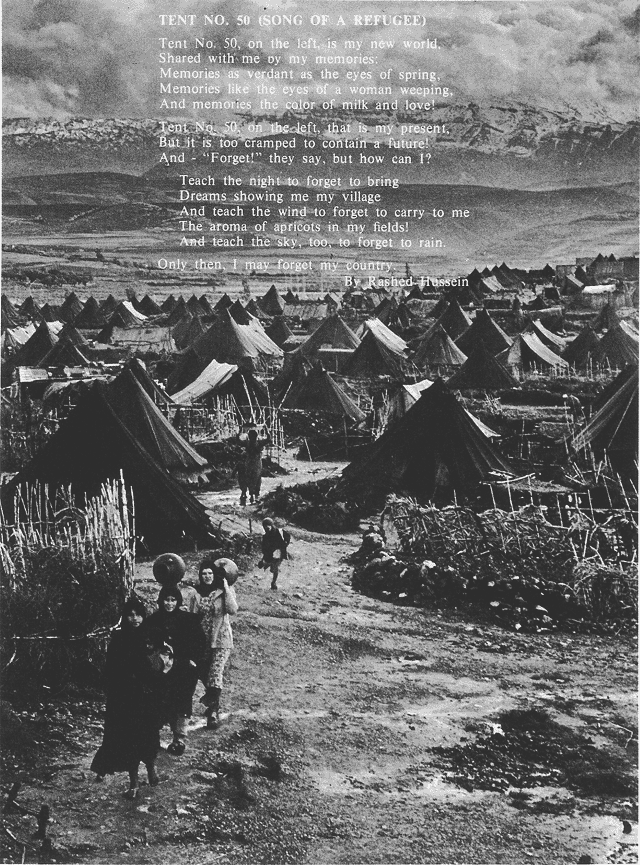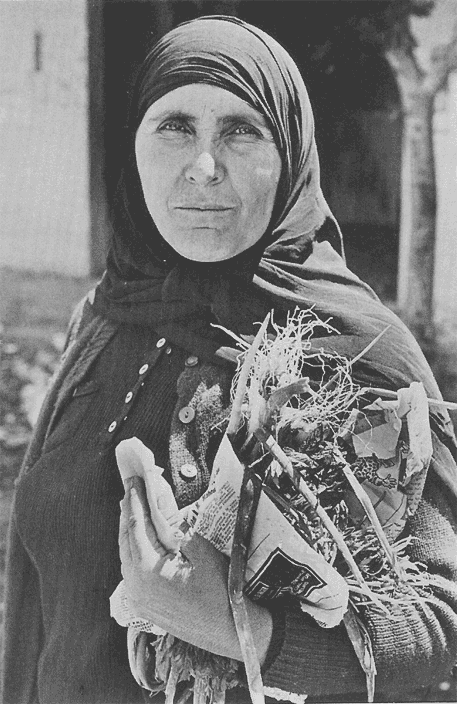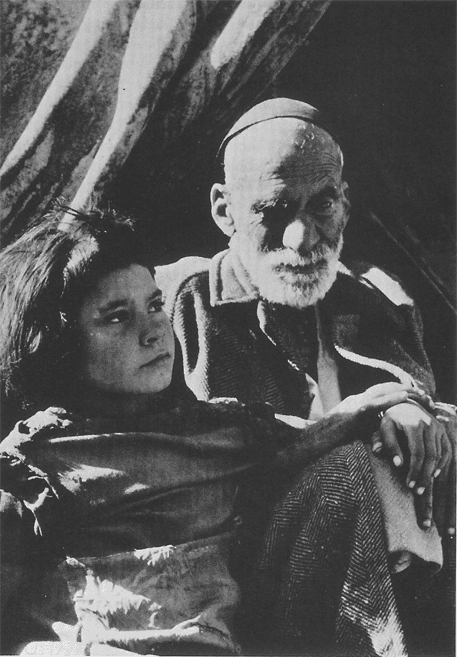Our Roots Are Still Alive - Chapter 9
Previous: Chapter 8
Table of Contents
Next: Chapter 10
New Jersey Solidarity-Activists for the Liberation of Palestine Main Site

- Teach the night to forget to bring
Dreams showing me my village
And teach the wind to forget to carry to me
The aroma of apricots in my fields!
And teach the sky, too, to forget to rain.
Only then, I may forget my country.
- Rashed Hussein
The winter of 1949, the first winter of exile for more than seven hundred fifty thousand Palestinians, was cold and hard. Snow glistened on the mountains of Lebanon and the Galilee as thousands of families trudged along the roads seeking shelter. Families huddled in caves, abandoned huts, or makeshift tents which tore, were patched, and tore again as the cold rains pounded the ancient material. In October of 1948 the U.S. ambassador to Egypt reported that "thousands of refugees would die of cold if help was not sent soon."1 As the United Nations debated the status of the refugees and Americans sent donations to Israel, forty people died of cold each night in the Ramallah area of Jordan.2 Food was scarce. The New York Times of February 27, 1949 stated:
- American eyewitnesses in Jordan told of swarms of children with matchstick arms and legs and protruding bellies produced by progressive starvation and of babies dying because there was no milk.
Many of the starving were only miles away from their own vegetable gardens and orchards in occupied Palestine - the new state of Israel. Months before, in July of 1948, David Ben-Gurion had stated the Zionist policy toward the refugees: "We shall do everything possible to ensure that they never return."3
The American press placed no blame on Israel for the exiles. When they mentioned the "refugee problem," the newspapers told their readers that the solution was simple: Arab countries could easily absorb all the refugees. This solution, of course, was unacceptable to the exiles. They were tied to Palestine no just by livelihood, but by thousands of threads that link a people to their country. Also, the Arab countries who received the streams of refugees - four hundred sixty thousand in Jordan, two hundred thousand in the Gaza Strip, one hundred thousand in Lebanon and eighty-five thousand in Syria - were poor. Western colonialism had taken its toll. Arab cities were already swollen with people looking for work. Egypt, for example, exported cotton to the West, but lacked enough food to feed its own people. Lebanon spent 20 percent of its annual budget on food and shelter for the Palestinians,4 but it was not enough. Religious organizations and individuals added their aid, but still the needs of three-quarters of a million displaced people were staggering. Some Palestinians had money, connections or saleable skills to ease the pain of exile. But most arrived with nothing.
At the end of 1949 the United Nations finally acted. It set up the United Nations Relief and Works Administration (UNRWA) to take over sixty refugee camps from voluntary agencies. It managed to keep people alive, but only barely. Refugees who qualified for aid received roughly thirty-seven dollars a year. ID cards branded each person as a permanent refugee. Since there was little possibility of refugees getting jobs, UNRWA made an institution of hunger and humiliation.
The Disinherited
Three hundred thousand Palestinians were crowded into refugee camps located on desolate land. There was no sanitation and only basic health care in the camps. For the first several months of exile, nightly radio broadcasts named those who had died in the war. In this way families learned the fate of relatives. Some were close by in exile; others were in distant camps or in occupied Palestine. As men who had stayed behind in Palestine to fight found their families again, the joy of reunion turned quickly to despair. There was nothing to do, no way to ease the hunger of the children, to keep them warm and dry, to find a book to teach them to read. Many people had been farmers; now there was no land. Traders, craftspeople and professionals lived in the camps with no outlet for their skills.

Days passed by as people waited in endless lines - lines for water, lines for food, lines for medicine. The simplest household task took hours. Some jobs, like cleaning, were impossible, as every rain turned the "floor" of a tent into mud. Women gave birth with only the help of neighbors. A baby born in the cold and rainy winter survived with donations of clothes and extra food rations from neighbors. Oil lamps ineffectively heated the tents with a misty steam. The traditions of celebration at the birth of a child were haunted by the question: What can the future hold?

"We studied like ones possessed."
For Palestinians in the Arab cities, the future was not much brighter. Thousands crowded into the slums of Beirut, Amman and Damascus. In a 1953 visit, a British journalist described the scene in a mosque, an Islamic house of worship, where refugees had lived for three years:
- At first I could see nothing. The little light there was yellow and sticky like fog. Then I got used to it. High above, the whitewash of the domed roof was stained with patches of brown damp; water ran down the walls. The floor space was stone-paved and black from use. It was partitioned - if that is not the wrong word for such flimsiness. Ropes were slung from wall to wall. Odd poles stuck in the floor, supported them. And from them hung drab strips of sacking, patched, torn and brown with age. These strips were the walls of he partitions, and each pen - that is the right word - was a home and in the mosque were twenty-three families.5
Preparing to Return
The journalist accurately reported the misery faced by Palestinian refugees each day. But he missed the seeds of a new life that were growing out of the poverty and humiliation. Fawaz Turki, a Palestinian who grew up in a refugee camp in Lebanon, wrote:
- Those people outside the camp (not to mention the Western "tourists" with their blessed sympathy, their cameras, their sociological degrees, and their methodological and statistical charts) seeing our tattered rags hanging on us like white flags of surrender... did not know what we had. A feeling inside us. Growing. A hope.6

At night in the camps, Palestinians gathered inside a tent to play the oud, a Palestinian stringed instrument, or dance the dabke, a village folkdance of Palestine. Women hoarded small bits of thread to embroider traditional designs on a daughter's wedding dress. People from the same village in Palestine found each other and passed around cherished snapshots, discussing the fate of their olive trees or planning a spring planting on their return to Palestine. Women wondered aloud if the Israeli immigrants living in their house would cut down the jasmine or remember to mend the wall by the garden in the spring.
Just as often, people clustered around poets who recited the stories of Ramleh and Lydda or sang of the 1936 rebellion. Children learned from the poets about Palestinian history and resistance. They made up games of evading the Israeli border patrols and returning to Palestine to bring back a treasured heirloom or a favorite possession of their mothers.
Parents strongly urged their children to study as a way of escaping the deadliness of camp life. In makeshift classrooms, teachers encountered their most eager students. One Palestinian described her generation as studying "like one possessed." Worn newspapers and leaflets with news of resistance to Israel were passed from tent to tent. Palestinians were preparing for one thing only - to return home. Life magazine reported in 1951:
- The refugees don't want to be compensated for their lost lands and homes. They don't want to be sent off anywhere. They want to go home to what they consider property theirs.
"I want to go to my home," said Said Kewash, a lean-faced man who comes from Mayroon, near the Lebanese border. "I will never change this idea no matter what they offer me. There is no place in the world, not even Truman's White House that I would take for my home."
Maud Saleem agrees. He says he has the key to his home in his pocket and he has told his son that if he dies, the key is to be buried with him.7
The United Nations, in November of 1948, affirmed the right of the refugees to return to Palestine, resolving:
- ... refugees wishing to return to their homes and live in peace with their neighbors would be allowed to do so as soon as practicable, and that compensation would be paid for the property of those choosing not to return.8
As Said Kewash and Maud Saleem stated, the refugees were not interested in "compensation." Real compensation, which Professor Samuel Penrose of the American University of Beirut calculated in 1953 at $12 billion, was never under discussion.9 The return of refugees received even less attention. The United States, the main ally of Israel, vetoed every United Nations resolution that might allow a trickle of refugees to re-enter their homeland. Refugees in the camps confirmed that the expulsion of Palestinians by Israeli soldiers continued.
On May 5, 1951 General Bennike, head of the United Nations Treaty Supervision Organization, reported that Israeli troops had expelled seven thousand Arabs from el-Auja, a demilitarized zone near Egypt, and added the territory to Israel.10 Nothing was done. As reports of Israeli violations of the cease-fire filled the UN offices, Palestinians affirmed that return to Palestine was the only issue. Israel's only offer involving return of Palestinians was to accept one hundred thousand refugees from the Gaza Strip, if the Strip were added to the state of Israel.11
Palestinians rejected this solution and any other that did not promise the return of their land. In 1950, twenty-five thousand refugees went on a hunger strike against UNRWA, stating they would rather starve than settle outside Palestine. When UNRWA built concrete houses to replace the tent settlements, Palestinians in the camps began destroying the new buildings until they were assured that better houses did no mean they were giving up their claim to return to Palestine.12
Young Palestinians saw the role that the Western powers had played in creating Israel from the start. In Beirut, Amman and Damascus, they joined other demonstrators in marches to the American Embassy and the United States Information Agency to protest the growing role of the United States in the Middle East. At the demonstrations they spoke of the history of the conflict between Zionism and the Palestinian nation. On important anniversaries like November 2, the date of the Balfour Declaration, or May 15, the date of the creation of Israel, Palestinians led student strikes and marches through the Arab cities. Even elementary school pupils participated.

Children learned the history of Palestine from the old.
Palestinians protested not only against Israel and the United States. In 1951 the Committee for Resisting Peace with Israel began distributing in the camps and cities leaflets that exposed the deals that Arab leaders, especially King Abdullah of Jordan, were making with the Israelis. Demonstrations broke out in Jordan. That year a Palestinian tailor from Jerusalem shot and killed Abdullah as he was leaving a mosque.
Abdullah and his successor, King Hussein, ordered Jordanian police to help Israel guard its new borders against the return of the Palestinians. It was at these borders that protest became face-to-face confrontations with the new "owners" of Palestine. The jagged line of barbed wire outlining Israel's border had been erected in 1948, wherever Israeli troops had advanced. Often it divided villages down the middle, separated cattle from their grazing land and tore farmers from their fields. Over one hundred thirty thousand farmers in eighty villages along the Israeli-Jordanian border were cut off from their fields. They could not even qualify for UN aid; they had "only" lost their source of income, not both their homes and source of income, as UNRWA required.13
That first spring of exile the Israeli government allowed Palestinian farmers to cross the border to plant their fields. In the fall Israel decided they could not return to cultivate their crops. As people came to pick their oranges or harvest their wheat, they were met by the border patrol. Sir John Glubb reported in the quarterly journal Foreign Affairs: "A great number of them were shot dead, without question or answer, by the first Israeli patrol they met. Others were maltreated or tortured."14 The Israelis claimed that the farmers were "infiltrators." In reality, most were trying to reweave their lives after the horrors of war. The Palestinian write Turki explained:
- A great many of these simple folk, to whom politics, war and frontiers were alien concepts, had the naive notion that once the hostilities had ceased they could return home to resume their lives, to meet the members of their families they had left behind, to sleep in their warm houses, and to be in their orange groves - for soon it would be the orange-picking season.15
Israeli guns shattered these innocent assumptions forever. Merchants crossing Beersheeba from the Gaza Strip, their pack animals loaded with rice and sugar, found their centuries-old caravan routes blocked by Israeli troops. Israeli bullets killed others as they looked for work or searched for relatives. Soon many people had fathers and sons, mothers and daughters who had been killed on the Gaza caravan, at the Jordanian border, or in their own olive groves. Many Palestinians no longer crossed the border unarmed. The longing to return home, among students, farmers, and camp-dwellers, gave way to a determined search for the path back to Palestine.
Footnotes
- New York Times, 17 October 1948, cited in The ABC of the Palestine Problem, 2 vols., Arab Women's Information Committee (Beirut: 1969 and 1974), 2:9.
- Ibid.
- Michael Bar-Zohar, Ben-Gurion (French Edition), cited by Maxime Rodinson, Israel and the Arabs (Middlesex: 1970), p. 66.
- "Peace and Refugees in the Middle East," Middle East Journal (July 1949), p. 252.
- Owen Tweedy, "The Arab Refugees," International Affairs (July 1952), p. 339.
- Fawaz Turki, The Disinherited (New York: 1972), p. 46.
- James Bell, "Forgotten Arab Refugees," Life, 17 September 1951, pp. 91, 92ff.
- United Nations General Assembly Resolution 194 (3/1), para. 11, 11 December 1948, cited by Rodinson, p. 66.
- Samuel Penrose, The Palestine Problem: Retrospect and Prospect (New York: 1954), p. 18, cited in The ABC of the Palestine Problem, 2:11.
- Fayez Sayegh, The Record of Israel at the United Nations (New York: 1957), p. 46, cited in The ABC of the Palestine Problem, 2:9.
- Rodinson, p. 66.
- Leila Kadi, ed., Basic Political Documents of the Armed Palestinian Resistance Movement (Beirut: 1969), p. 15.
- Janet Abu-Lughod, p. 161, and Gerard Chaliand, The Palestinian Resistance (Middlesex: 1972), p. 36.
- Cited by Turki, p. 38.
- Turki, p. 38.